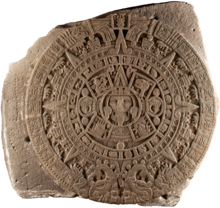
Back حجر تقويم الأزتك Arabic آزتک ایلسایار داشی AZB Камень Сонца Byelorussian Камень Сонца BE-X-OLD পিয়েদ্রা দেল সোল Bengali/Bangla Sluneční kámen Czech Stein der Sonne German Sunŝtono Esperanto Piedra del Sol Spanish Asteegi kalendrikivi Estonian
19°25′34″N 99°11′15″W / 19.42611°N 99.18750°W
| Mexica sun stone | |
|---|---|
 | |
| Material | Basalt |
| Created | Sometime between 1502 and 1520 |
| Discovered | 17 December 1790 at El Zócalo, Mexico City |
| Present location | National Anthropology Museum (Mexico City) |
| Period | Post-Classical |
| Culture | Mexica |
3D model (click to interact) | |
The Aztec sun stone (Spanish: Piedra del Sol) is a late post-classic Mexica sculpture housed in the National Anthropology Museum in Mexico City, and is perhaps the most famous work of Mexica sculpture.[1] It measures 3.6 metres (12 ft) in diameter and 98 centimetres (39 in) thick, and weighs 24,590 kg (54,210 lb).[2] Shortly after the Spanish conquest, the monolithic sculpture was buried in the Zócalo, the main square of Mexico City. It was rediscovered on 17 December 1790 during repairs on the Mexico City Cathedral.[3] Following its rediscovery, the sun stone was mounted on an exterior wall of the cathedral, where it remained until 1885.[4] Early scholars initially thought that the stone was carved in the 1470s, though modern research suggests that it was carved some time between 1502 and 1521.[5]
- ^ "National Anthropology Museum, Mexico City, "Sun Stone"". Archived from the original on 2014-04-07. Retrieved 2014-04-06.
- ^ Ordóñez, Esequiel (1893). La roca del Calendario Azteca (Primera Edición edición). México: Imprenta del Gobierno Federal. pp. 326–331.
- ^ Florescano, Enrique (2006). National Narratives in Mexico. Nancy T. Hancock (trans.), Raul Velasquez (illus.) (English-language edition of Historia de las historias de la nación mexicana, 2002 [Mexico City:Taurus] ed.). Norman: University of Oklahoma Press. ISBN 0-8061-3701-0. OCLC 62857841.
- ^ Getty Museum, "Aztec Calendar Stone" getty.edu, accessed 22 August 2018
- ^ Villela, Khristaan. "The Aztec Calendar Stone or Sun Stone", MexicoLore. Retrieved December 17, 2015.
© MMXXIII Rich X Search. We shall prevail. All rights reserved. Rich X Search